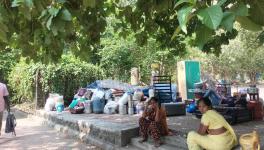Mumbai’s Mill Workers : A Small but Significant Victory
On the 28th of June 2012, the Government of Maharashtra (GoM) will conduct the lottery for the distribution of 6948 tenements, the first phase of housing built for out-of-work textile mill workers.
The 225 sq feet tenements have been built by the Maharashtra Housing Development Corporation (MHADA) on a part of the land of closed textile mills. GoM has also set up a committee which is in the process of identifying more land to build more houses. The land needed is vast, since 1,45,000 textile workers have applied, and they have all been promised houses by the government, in lieu of the jobs they have lost. This is perhaps the first time that workers have won rights over industrial land, even a small part, and demanded and secured houses in lieu of jobs.
This is a culmination of a decade of struggle, just on the demand for housing. The main rationale of the demand for housing rights on cotton textile mill lands, has been that these lands were leased to mill-owners a century ago at rates as low as a rupee a metre, and if the land has now turned into prime real estate, and the industry shut down, there is no justification for the appropriation of the real estate value (now astronomical) by the mill-owners alone. The citizens of the city and the workers working in the mills should have a right too. That this is not a wild and unreasonable demand is validated by the fact that it was never permissible to sell mill lands. It was only in 1991 under pressure from the mill owners who claimed they needed to sell land in order to revive and modernize their sick mills, that the GoM obligingly allowed sale. Again, the closure of textile mills, and the redevelopment of the land does not affect just the workers and their families but the community living in what is called Girangaon (Village of Mills), and the entire city. Today, the shabby vestiges of the old mill precinct: the chawls and derelict mill structures seem to cling hopelessly to life in the midst of the dazzling array of high rise shopping malls and luxury apartments. However mill workers have kept on fighting. Not as a trade union, any more, more as a social movement, organizing, not just as out-of-work workers, but also as residents, women, youth, tenants.
Jobs vs real estate
Girangaon covers 600 acres in the middle of the island city. The rate for an apartment in this area is between 28000 to 50000 rupees per sq foot. Until 1996 there were 54 textile mills in Mumbai: 29 privately owned, and 25 in the state sector, ie chiefly the National Textile Corporation (NTC) which was formed in 1974 after nationalization of sick mills. Today almost all are closed. Major sickness in the textile industry set in around the 1980s, mainly due to diversion of profits and lack of modernization. This coincided with the Datta Samant led textile workers strike in 1982, and the boom in Mumbai’s real estate. Even after the mills opened after the collapse of the strike, ten mills were closed, the workers out on the streets without pay or even their legal dues. The textile strike of 1982 was never called off. This created a strange situation in which workers went back to work, the strike collapsed, and the then popular union led by Datta Samant became inactive. Workers belonging to the 10 closed mills, organized in an independent platform called Bandh Girni Kamgar Sangharsh Samiti (BGKSS), forerunner of the current Girni Kamgar Sangharsh Samiti (GKSS). The struggle launched by the BGKSS, supported by almost all political parties, resulted in the re-opening of 7 mills. However the combined assault of textile sickness, apathy of the central and state government towards the problem and the determination of the mill owners to cash in on the real estate bonanza, spelt the doom of the mills and Girangaon. Yet mill workers continued to fight, because, as some say, they know no other way to be.
In 1991 the GoM permitted sale and development of mill lands, on the stated condition that the money be used solely for revival and modernization of mills. The new Development Control Regulations (DCR), 1991 allowed sale of mill land on the basis that 1/3 of the land should be handed over to the Municipal Corporation for open space for the city, 1/3 for affordable housing to MHADA, and 1/3 could be developed by the millowners. In exchange for the two thirds given up, the owners were guaranteed equal land as TDR (Transfer of Development Rights) outside the island city. Besides, there were enough exemptions and loopholes to make things easier. They did not really lose much.
As a result of the continuous struggle led by the GKSS, the GoM finally accepted in principle, the rights of the mill workers also to the mill land. In 2001 the DCR was amended again. The 2001 DCR gave protection (against eviction) to tenants of existing chawls on mill land, it set up a monitoring committee for payment of compensation to mill workers, it mandated that children of the workers should be given jobs in enterprises coming up on mill lands. It also reserved half of MHADA’s 1/3 for mill workers housing. This sounded, on the face of it, like a victory both for the city as well as for mill workers specifically. It meant that 200 acres should be made available for open space and an equal amount of space to build workers and affordable housing.
Then came the GoM’s notorious ‘interpretation’ from bureaucrat Ramanand Tiwari (of Adarsh scam fame) saying that the 1/3 formula now applied only the open space (ie not built up) part of the huge mill lands. This left the workers and the city shocked, and with very miniscule portions. It was challenged by BEAG (Bombay Environmental Action Group), for Mumbai’s citizens, and GoM interpretation was struck down by the Mumbai High Court. However the mill owners, supported by a barrage of the highest priced lawyers in the country, approached and won in the Supreme Court in 2006; an episode that was a historic defeat for all Mumbaikars.
The struggle for housing
The GKSS came together with other unions on the initiative of Jayashree Khadilkar, Editor of Marathi newspaper Navakaal, to continue the struggle, in 2011. Unions which had earlier opposed the demand for housing saying this was tantamount to an acceptance of the sale of mill land and by default the closure of mills, had by now also started to support the demand. The GoM had already entrusted MHADA with the job of building the tenements for the mill workers on the reduced area of mill land that was now available for the purpose, i.e. 32438.46 sq metres.
The united agitation enjoyed the support of all the political parties in the state. The first march saw the participation of 50,000 people. After a time, Chief Minister Prithviraj Chauhan accepted the demand of houses for all the workers on the rolls before 1982, and set up a committee to identify more land, not necessarily in the mill area, for this purpose. The price, which had been a sticking point also, was finally pegged by the govt. at Rs 7.5 lakhs per unit, ie Rs.3333 per sq ft, which is still high for out of work workers, yet very low compared to the prevailing market price of about Rs.30,000 per sq ft. The cost includes a subsidy of Rs 2, 00, 000 per unit from the BSUP (Basic Services to the Urban Poor), the Central govt’s housing scheme. Loans at low rates of interest are to be made available as well so that mill workers are able to buy.
However, an already existing difference of opinion now turned into an ugly division among the unions. The Shiv Sena, the BJP, CPI and Lal Nishan affiliated unions demand that the houses be totally free. On the other hand, the GKSS, the Datta Samant union (MGKU), the Congress led RMMS and Jayshree Khadilkar say that the demand is untenable at this stage, and would be tantamount to depriving the workers of what they can get. They also point out that all unions had accepted that the houses would be at cost in 2004 when the then Chief Minster Vilasrao Deshmukh had held its first consultation with unions before declaring the scheme so this is hardly sacrilege. The division has to some extent, weakened the pressure that should have been brought to bear on the government to get more, in terms of numbers, pricing, terms and quality.
The free housing group has not specified where the money for construction will come from, but evidently one option is that it be based on the principle of the builder -inspired Slum Re-development Authority (SRA) scheme, whereby the builder can cross-subsidize free tenements for slum dwellers by building high-end apartments blocks on most of the land, leaving a miniscule bit for the poor. The quality of the houses that are built under these schemes are notoriously bad. MHADA construction is far better. Perhaps realising that SRA is not tenable given the paucity of land in the mill area, the ‘free housing or nothing unions’ say that the houses can be financed by taxing the mill-owners, a measure which, while extremely appealing, is clearly impossible under the current financial architecture in India; and has not been achieved even under left governments so far. In any case, these unions have demanded a stop to the lottery on 28th June. When cornered, the Shramik-Lal Nishan has gone on record to say that this is a political positioning, although they know it will not happen, and that they permit their own members to accept the houses if they are allotted them, by paying the cost. What is surprising is the vicious and abusive attack that Lal Nishan and CPI have launched on those who do not agree with them. In 2008, the Shramik union even organized demonstrations against the other unions, to force them to demand free housing, an action which resulted in the GKSS losing its union office in the small chawl where it was renting.
The ‘free housing or nothing unions’ are not supported by the CPM led CITU, or indeed any of the independent unions, as far as our information goes. Raj Thakeray’s MNS at first supported free housing, then withdrew. If the lottery goes ahead as scheduled, every single worker-allottee is likely to accept the houses. They will see it as a victory, not defeat. The GKSS, RMMS and others will be marching to the Mantralaya on the 20th of June, demanding that the process of finding land and homes for all the workers, be speeded up, and the lottery, already delayed for two years, be held as scheduled.
Image Courtesy: Omrita Nandi
Get the latest reports & analysis with people's perspective on Protests, movements & deep analytical videos, discussions of the current affairs in your Telegram app. Subscribe to NewsClick's Telegram channel & get Real-Time updates on stories, as they get published on our website.
























